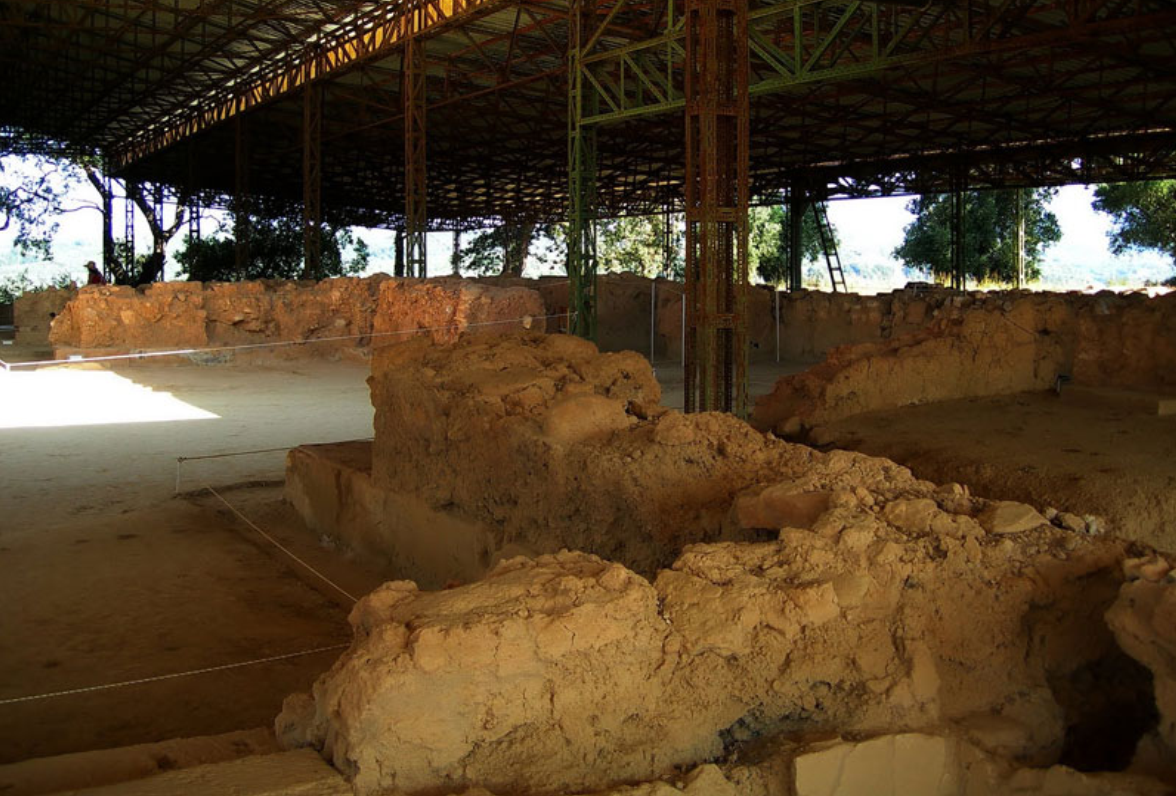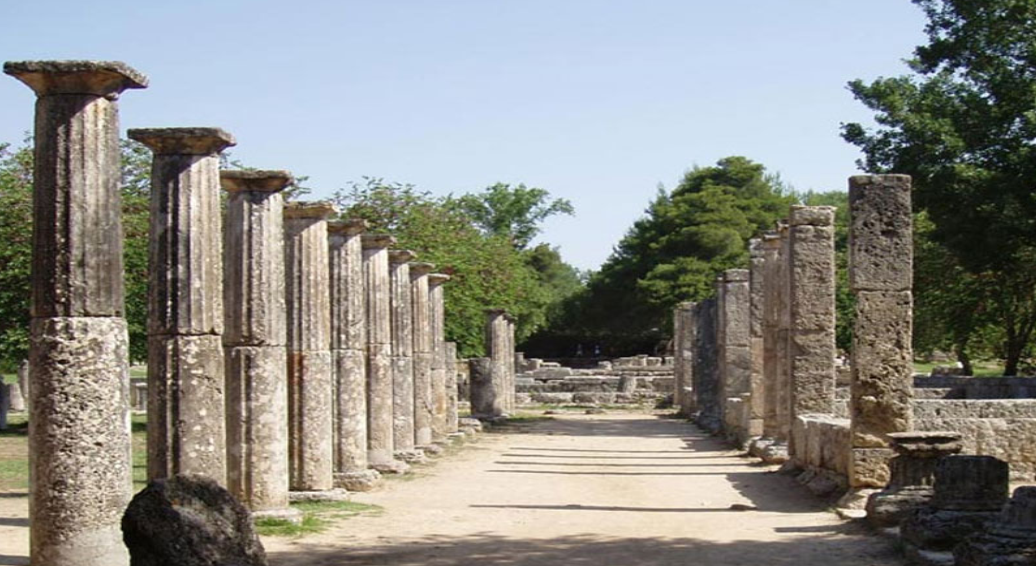PALACE OF NESTOR




The palace complex consists of four buildings, including a number of apartments. The colorful frescoes decorating the interior are impressing, as well as the fact that the palace was never surrounded by a protective wall, since its location was sufficient to provide it with appropriate protection. The palace seems to have been completely destroyed by a fire in the 12th century BC, but it has managed to preserve a plethora of ceramic plaques that provide us with important information about the economic, social and religious life during the Mycenaean times. Visitors to the area can also see the vaulted tomb attributed to Nestor and his successor, Thrasimidis, discovered next to the palaces, as well as all the archaeological finds from the excavations, which are exhibited at the Museum of Chora.
The Mycenaean civilization was developed between 1700 and 1001 BC. in different parts of Greece. Its archaeological traces were first found in the Mycenaean area, from which it was named. Among the most important findings that this brilliant culture has bequeathed to us , are the vaulted tombs and this majestic palace.
The palace of the mythical king of Pylos, Nestor, belongs to this category of Mycenaean palaces, and is the best preserved of all that has been discovered all over Greece. It is located 4 km south of Chora village, on the hill of Upper Eglianos, 14 km from Pylos. The palace was built in the 13th century BC. by King Nestor, the son of Nileas, who is often mentioned by Homer, having an important place in the Homeric epics. Nestor led Pylos to the Trojan War with 90 ships and was presented by Homer as a prudent elder, whose opinion was always respected by the Achaeans.
The first investigations to locate this mythical palace began in 1888 by Heinrich Schliemann, who had some suspicions about its location, but he did not find it. This was done in 1939 by Konstantinos Kourouniotis, who along with Carl Bergen carried out intensive excavations until the first findings of the palace came to light. The Second World War put a brake on the excavations for some time, and they began again in 1952. Although most of the palace has already come to light, research continues with the participation of the University of Cincinnati, USA.
Numerous archaeological finds from the palace of Nestor are kept today at the Archaeological Museum of Chora.
How do you go?
Driving through EC9 • 18.1km.25 min.
ITHOMi
Ithomi was an ancient fort located in Messenia
The fort consisted of successive peaks and fortified mountain passes. Remains of the fortification enclosure are preserved. The south access to the acropolis was also fortified. At the highest peak (about 800 m high), today is the old monastery of Panagia Voulkanos. The area is relatively smooth and extensive so that it could be inhabited, although only in extremely unfavorable circumstances due to the difficult access (for the same reason the old Vulcan monastery was abandoned later). On the path to the summit of Ithomi, relics of a waterway and rock carvings have been observed, perhaps there was the Klepsyra fountain mentioned by the traveler Pausanias (others claim that Clepsydra is today's source inside of Mavromati).
The mountain was dedicated to Zeus the Ithomata, and at its top there was a sanctuary with an altar. Pausanias mentions that the Messenians claimed the birth and nurture of Zeus in their land and that they brought daily water to the holy summit from the source of Clepsydra. There has been talk of the similarity of the worship of Zeus Ithomata with that of Arcadian Lycaea Jupiter. This similarity is reminiscent of the incident reported by Clement of Alexandria, namely the man-sacrifice of 300 captives of Lacedaemon, including King Theopompos, from the Messenian rebel hero Aristomenis, during the Second Messenian War.
The Fortress of Ithome played an important role in the Messenian War, towards the end of the 7th century BC, between Messinia and Sparta. It was the last bastion of the Messinians, and eventually it was razed after a heroic siege.
In the following years, Ithomi played a symbolic role in the heart of the enslaved Messinians. Thus, when the helots revolted in 468 BC. (C Messinian War), they resorted to this part, rebuilt fortifications and resisted from there for a long time. Gradually, the Spartans tightened the ring around Ithomi . With great difficulty and with the help of their allies they forced the helots to capitulate, probably in 459 BC. Under the terms of the treaty, the besieged Messenians were released with their families from the Peloponnese and settled by the Athenians in Nafpaktos.
source wikipedia ( Ithomi )
How do you go?
Driving through EC9 and Kyparissia Knossos • 80.6km1hr. 36 min.




ANCIENT MESSENE




Ancient Messene was founded in 369 BC.
In the south-western part of the Peloponnese, next to the present village of Mavromati, in ancient times was the city of Messina, one of the most important ancient towns in the region with a significant historical presence. The city was founded in 369 BC. by Theban General Epaminondas and his Argian allies, in order to exclude the Spartans from the Messinian region.
This particular location for the founding of the new city is said to have been chosen after the miraculous discovery of the place where the will of Aristomenis, the Messianic hero, was made with the help of priests and oracles. According to Pausanias, for the colonization of the new city, the Messenian immigrants were called back from Italy, Sicily, the Euspérides in Libya, as well as to several other cities where they had fled. Most responded positively to the call for the settlement of the new city and, along with the liberated helots and the inhabitants of the area, they became the first citizens of Messina. The city took its name from the mythical, queen of the country, who was the daughter of arcadian king Triopa and his wife Lakon Polykaona. According to Pausanias, Messina was deified around the 10th century BC. and gradually proclaimed one of the main deities of the city.
Ancient Messini was surrounded by a wall about 9.5 km long, the largest part of which still stands today. It included two gates, Arcadia (or Megalopolis gate) and Laconian. The latter was destroyed in the 18th century, but the first, Arcadia, was preserved in good condition, and it was the trademark of the city for the first travelers, who used to depict it in their copper engravings. It is a huge, imposing portal, circular, with two entrances, an inner and an outer one. In ancient Messina, the theater, the Agora, the sanctuary of Demeter and the Dioscuri, the Zeus Savior and Isis and Sarapidos, the sanctuary of a hero, the imposing Arsinoe Fountain, a great Doric temple, the Asclepius, were the brightest public building, the ecclesiastical church, somehow reminiscent of a small theater, the stadium, the gymnasium and, from later times, a basilica of the early Byzantine times.
The layout of the city followed the so-called Hippodamian system, where all the buildings had the same orientation and the space was divided into horizontal and vertical axes. Inspired by this system was Milesios Hippodamos, an architect, geometr, astronomer and astronomer who lived around the 5th century BC, who supported his system on the principles of equality, equality and equality, which constituted the principles of the democratic government. The city fell victim to a raid by the Goths in 395 AD. under Alaricus, when he began gradually to be deserted. It certainly does not cease to be one of the most well preserved cities of the ancient world and one of the most interesting archaeological destinations.
How do you go?
Driving via Cc. Thouria-Chora • 50,6 km1 hr. 10 min
ANCIENT OLYMPIA
Olympia lies in the wide valley of Alpheios River
Olympia was in ancient times a sacred site dedicated to Zeus, with events that were introduced every four years in honor of the well-known Olympic Games. The first races were held in 776 BC when, according to tradition, Lycurgus from Sparta came to an agreement with Iphitos, the king of Ilida, about the establishment of devotional events in Olympia in honor of the god. In fact, it was agreed that a truce would prevail throughout Greece. The celebrations were organized every four years, until 393 AD, when the emperor Theodosius I abolished them, denouncing them as a pagan custom. The games were revived much later in 1896 when, at the initiative of Baron Pierre de Coubertin, they re-organized in their hometown many centuries ago and have since established themselves as a world event.
The discovery of the site was made in 1766, but the excavations began later in 1829 by the French Scientific Mission in the Peloponnese. The first major excavation began in 1875, led by German archaeologist Ernst Curtius. Until 1881 important findings had come to light, such as the well-known Hermes of Praxiteles and Peony's Nike. Between 1908 and 1929, excavations were carried out by Wilhelm Dörpfeld. Between 1952 and 1966, the excavations in Olympia worked by Emil Kunze, Hans Schleif and Alfred Mallwitz. Since then, many researches have taken place, many dates have been confirmed and numerous figures have come to light. Investigations continue to date, as the archaeological site seems to have much to reveal.
At the center of the archaeological site is Altis, the sacred forest, which includes the most important buildings. Here is the magnificent temple of Zeus, one of the most remarkable monuments in the area, as it is considered to be the largest temple of the Peloponnese, and in this place the 13-meter-long golden statue of Zeus, made by the sculptor Pheidias in the 430 BC, X. This statue was considered one of the seven wonders of the world. According to the votive inscription of the Lacedaemonians, the temple was built in 456 BC. and is a Doric temple pattern. To the north there is an older temple dedicated to Hera. This temple must have been built around 600 BC, as a tribute to the sanctuary of Olympia by the inhabitants of Skillounta, an ancient city of Ilia. The temple was one of the most important and most valuable works of the sanctuary, Hermes of Praxiteles.
The temple today survives only fragmentarily, while some of its fragments are kept in the Archaeological Museum of Olympia. There is also the Registry, a temple dedicated to Rea-Kyveli, the mother of the gods, and behind it the treasures raised by Greek cities and colonies as tributes. To the west stands Nymfaio: it was an aqueduct that Herod Atticus dedicated to the sanctuary. Apart from these, there was the Philippe, a tribute to Philip II, the Prytanio, the Pelopio, and a multitude of altars, statues and statues. Apart from Altheos, one could see the Bouleuterion, the South Stoa, the Gymnasium where the athletes, the Palaestra, the workshop of Pheidias, the Baths, the Leonidio, the Nero's villa, and of course the Stadium where the Olympic Games took place, with a capacity of 45,000 spectators.
How do you go?
Driving through EC9 • 90.4km.1hr. 40 min.






